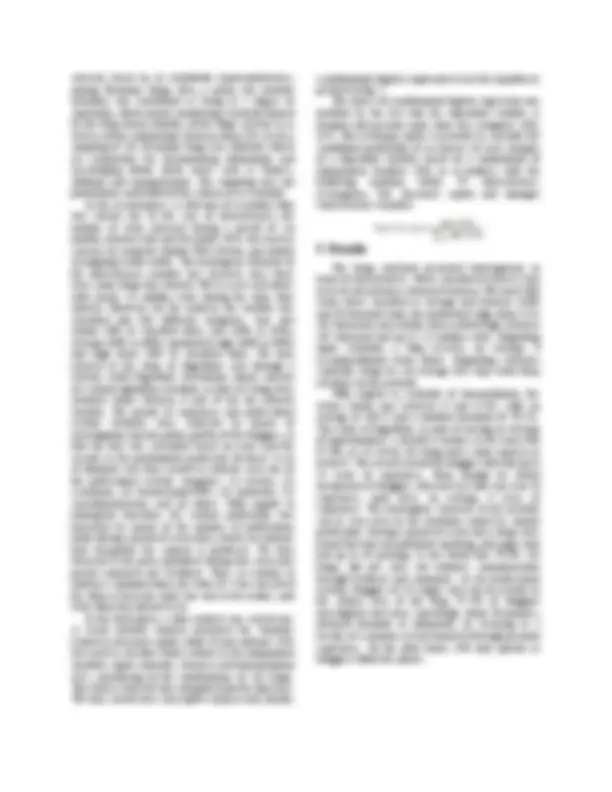








Study with the several resources on Docsity

Earn points by helping other students or get them with a premium plan


Prepare for your exams
Study with the several resources on Docsity

Earn points to download
Earn points by helping other students or get them with a premium plan
Community
Ask the community for help and clear up your study doubts
Discover the best universities in your country according to Docsity users
Free resources
Download our free guides on studying techniques, anxiety management strategies, and thesis advice from Docsity tutors
The relationship between managerial actions and network position in terms of structural capital in the context of blogs. It discusses how indicators such as input centrality, proximity, intermediation, and PageRank influence blog attractiveness. The document also examines the impact of work experience, professional performance, content publishing, and audience communication on this relationship.
What you will learn
Typology: Exercises
1 / 10

This page cannot be seen from the preview
Don't miss anything!







Carlos Denner dos SANTOS University of Brasília carlosdenner@unb.br
Isadora V. Castro University of Brasilia isadora.castro@gmail.com
George Kuk Nottingham Trent george.kuk@ntu.ac.uk
Silvia Onoyama EMBRAPA/Brazil silvia.onoyama@embrapa.br
Marina Moreira University of Brasilia marinamoreira@unb.br
Blog management is central to the digitalization of work. However, existing theories tend to focus on environmental influence rather than managerial control of a blog’s attractiveness at a microlevel. This study provides an agentive account of the adaptive behaviours exerted by the bloggers through the ways they use contents of their blogs to locate and harness their structural network positions of a blogosphere. We collated individual characteristics of 165 bloggers who blogged about economics, and then analysed the ways they maintained the contents of their blogs. We used network analysis and monomial logistic regression to test our model predictions. Our findings show that in contrast to less attractive blogs, bloggers who are mindful of their peers’ contents as a means of maintaining network positions attract a significantly higher level of traffic to their blogs. This agentive perspective offers practical insights into how nodal preferences can be reversed in blog management. We conclude the paper by discussing contributions to theory and future research.
Several studies have discussed blog management, structure and environment. In addition to the structural capital perspective [1], existing literature seems to prescribe an environmental perspective as a main mechanism of how blog management is being externally governed [2]. This mechanism means that the attractiveness of blogs tends to concentrate on a few and is irreversible [3]. While attractive blogs are favored indefinitely, the majority is prone to failure, overlooking actions taken by bloggers [4]–[6]. However, the everyday practice of blog management seems to suggest otherwise. In an attempt to reconcile theory and reality, we ask: how the
characteristic and managerial actions taken by a blogger influence a blog’s attractiveness? To do so, in this study, we combined the network and organizational perspectives to explain the variation of blog’s success by taking into account the managerial actions taken by the bloggers [7]–[10]. Although blog management may be restricted by contexts, the effects of the environment offer a partial explanation. An agentive perspective based on bloggers’ actions often runs counter to the complexity and dynamic characteristics of the organizations [10], [11]. Despite prior research on blogs [4], [5], [11]– [13], how blog management at a micro-managerial level plays out at a network level is less understood. It is relevant to clarify these relationships, not only within the framework of social media, but, especially, in organizational theories. When we understand which mechanisms are responsible for the evolution of an organization, we can ascertain how relationships are established and developed [14]. We examine the influence of managerial actions exerted by bloggers against environmental contingencies on the performance of these organizations [11], [15]. There are many theoretical perspectives that seek to explain the relationship between managers, organizations and environment [7]. From an organizational theory point of view, our research question draws upon a frequent debate between selection and adaptation from Organizational Ecology and Structural Contingency. We used social network analysis (SNA) to analytically test the links between managerial action and network position in terms of structural capital [1]–[3].
Irrespective of its functions, a blog can be designed for entertainment or served as a business tool [16]. The number of its subscribers and visitors (audience) represent indicators that can demonstrate its capacity to
produce material of interest. This is why such indicators are used by bloggers and related companies as one of the main ways of evaluating blog performance or attractiveness [17], [18]. In addition to managing their own pages, bloggers also read other blogs and, based on this, organize and make publicly available lists of recommended links that they consider relevant. These recommendations, describe different network pages, known as Blogosphere, making it possible to visualize the connections [19]. This network functions like a society of blogs and is based on following agreed-upon practices to ensure co-existence of an online community [20]. Structurally-speaking, a connection preference mechanism is the main reason for forming these relationships [6], [13]. More attractive blogs tend to become increasingly more attractive [2], [12], [21], generating a centralized structure, that is divided between central blogs, which hold a greater number of relationships whereas peripheral blogs hold fewer established relationships.
According to Organizational Ecology, organizations are at the mercy of the environment, in that failure or success is explained not in terms of managerial actions, but selective environmental processes [9]. The role of the managerial action is limited by four primary factors: (1) the organizational structure, which constrains individual behavior; (2) the lack of resources, which limits management activities; (3) the competition for resources, which reduces the possibility of strategic choices; and (4) the supremacy of the environment above individual rationality based on the assumption that the process of natural selection operates in the “collective”. In this respect, although prior research [9] does not dismiss managerial influence, the role of a manager is very often seen as being inactive or symbolic [7]. From the perspective of structural contingency, despite the indirect effect of the environment, organizational changes that are initially caused by internal factors will require internal structures to be realigned within the environmental contexts [10], [22]. Variations in the internal structures are found to be contingent with the environment. Often managerial actions are required to meet the environmental demands by functionally realigning internal structure to an external context [10], [23]. However, at the network level, an organizational structure captures the relationships between actors [21]. This perspective takes an agentive account based on actions and interactions between its network
participants, which forms the basis of structural capital based on a micro-level of analysis, denoting the benefits of different network positions [21]. From an environmental delineation point of view, networks comprise an open and dynamic system, where new actors are added and excluded all the time, and where their performance is not only influenced, but also determined by a connection preference mechanism [2], [4], [12], [21], [24]. It produces an effect known as “the rich get richer” [2], that imposes itself in a deterministic fashion [9], [25], whereby the actors are divided into two groups: (i) few individuals that are attractive, represent high levels of performance and tend to attract more connections over time; and (ii) the many individuals that are not attractive, result in low levels of performance and few connections. It presupposes new entrants connect to those more connected, so a novice blogger has to do is to wait for successful blogs to be abandoned, then set this up as a passive agent to establish the performance of his or her page, since the survival or death of a blog [9], [25] occurs irrespective of its adaptation capacity [26]. On the other hand, research into structural capital notes how a network structure and, consequently, the position of actors in this network, can produce performance variations, involving access to resources, time availability and access to information. One of the features that allows this variability is the actors’ ability to visualize existing structure of the network [21]. In the case of blogs, it is possible to observe this structure on recommendation lists available [19], [21]. Besides being viable, this analysis is highly interesting, since the network structure is public, so understanding and exploring prominent positions can be achieved, not only by media managers, but also by interested companies acting as partners [16], [21]. This statement supports the structural capital analysis of each actor for calculations to be made in terms of the centrality of degree, proximity, intermediation and PageRank [27], [28], as shown in Table 1. Depending on the measure utilized, centrality can be construed from different viewpoints [21], [27]. Because of their ability to predict the performance of a network participant, these measures also inter-relate in mathematical terms [31]. However, it is important to stress that different measures are not the same, not even in mathematical terms, nor in theoretical terms, despite being correlated [1], [21], [24], [32].
It is possible to observe the outcome of blog’s adjustment capacity and context (org. performance) by the size of its readership [18], [20], [28].
regarding audience, since an experienced blogger can act according to the lessons learned, thereby mitigating the effects of environmental vulnerabilities.
readers [41]. In content production, the presence of postings is essential. However, interaction by means of feedback, in spite of being a desirable element, is arbitrary [18], [42]. But when a blog allows comments to be written, an expectation for interaction is created. In this situation, a blogger has two options: either (a) to meet these expectations and establish communication, either by responding to a query or exchanging information; or (b) not to respond to the comment [41]. The first option is clearly beneficial, since, in addition to fulfilling his purpose, the blogger can explore the comments space to suggest other publications on the blog, explain a point of view in a better way, and to learn more about the needs and preferences of his or her readers [43]. On the other hand, making a communication channel available, but ignoring the blog reader, can generate, not only dissatisfaction, but also rejection [41]. An isolated action does not imply severe consequences, but, if failing to communicate becomes habitual to the point that a blog reader feels jeopardized, this can lead to a loss of readers and, consequently, to organizational failure. Thus, audience communication, instead of merely avoiding negative effects, involves gains, enabling a blogger to mitigate adverse underprivileged positions.
Figure 1. Blog attractiveness
Source: Developed by the authors.
This research method used various sources of secondary data and involved three phases. In the first phase, the empirical context and sampling were established. For this, a network such as one with a “snowball” effect, was outlined: firstly, a blog was
selected, based on its worldwide representativeness, among Economy blogs; then, a priori, the network boundary was established as being at 1 degree of separation, which meant considering a network formed by the blog chosen initially, all the blogs cited by it, as well as all the relationships between them [33]. In all, a sampling of 165 Economy blogs was obtained, which are responsible for disseminating information and encouraging debate about issues such as finance, inflation and unemployment. The sampling was not probabilistic and followed the criteria of accessibility. In the second phase, a collection of secondary data was carried out. In the case of attractiveness, the number of visits attracted during a period of six months, between July and December 2014, was used as a proxy, by using the Similar Web website, specialized in mapping visitor traffic. The heterogenic behavior of the attractiveness variable was checked, since there were some blogs that showed 500 accesses and others with nearly 1.6 million visits during the same time interval. However, for the analysis, the variable was classified into five different categories: very low (initial 20% of classified data), low (20% to 40%), average (40% to 60%), moderately high (60% to 80%) and high (final 20% of classified data). We then referred to the value of PageRank, also through a website called PageRank Calculation, which consists of a virtual algorithm calculator, so that 165 blogs were awarded values between 0 and 10 for the referred variable. The period of experience and professional activity variables were collected by means of investigations into the public profile of the bloggers, so that the first was calculated based on years and the second, as the predominate profession declared. A set of dummies was then created to indicate each one of the professional activity categories: (1) teacher, (2) economist, (3) businessman/CEO, (4) journalist, (5) consultant/investor, and (6) others. With regards to managerial functions, the content publication was measured by means of the number of publications made during a period of seven days, which can indicate how frequently the content is produced. We then observed if the posts published during this seven-day period contained any feedback. Thus, in relation to audience communication, the value of 1 was conceived for when at least one reply was sent to the readers, and 0 for when this did not occur. In the third phase, a data analysis was carried out. A social network analysis measured the variables related to structural capital, while Ucinet software (V6) was used to calculate values relative to the independent variables, input centrality, closeness and intermediation [45], considering all the combinations of 165 blogs. The values extracted were integrated into the data base. We then carried out a descriptive analysis and, finally,
a multinomial logistic regression to test the hypotheses pictured in fig. 1. The choice of a multinomial logistic regression was justified by the fact that the dependent variable is nominal and presents more than two categories [46], [47]. This technique makes it possible to calculate the conditional probability of occurrence of each category of a dependent variable, based on a combination of independent variables [48], in accordance with the following equation, where Y= attractiveness; j=categories; wi= structural capital and manager characteristics variables:
The blogs analyzed presented heterogeneity in terms of attractiveness. Those considered to have a low level of attractiveness obtained between 500 and 6. visits; those classified as average had between 6. and 18 thousand visits; the moderately high, from 35 to 102 thousand; and, finally, those ranked high, between 102 thousand and up to 1.6 million visits. Regarding input centrality, a blog receives, on average, 6 recommendations from others. Regarding closeness centrality, blogs are, on average, five steps away from all others on the network. With regards to centrality of intermediation, the values found vary between 0 and 8.285, with an average of 160.22 and a standard deviation of 705.85. The value of PageRank, in spite of having an average of approximately 5, showed a variance in the sense that 87.8%, or 145 of the 165 blogs had a value equal to or below 6. The research involved bloggers who had up to 14 years of experience. Even though we found inexperienced bloggers, who had less than one year of experience, most have, on average, 6 years of experience. The heterogenic character of the network can be seen even by the variations related to content publication. During a period of seven days, blogs were found that had not published anything, and pages that had up to 84 postings. It was found that 70.3% 116 blogs, did not carry out audience communication through feedback and comments. As for professional activity, bloggers of 141 pages carry out an activity in the subject area of the blog. 85.5% of bloggers investigated had basic knowledge about Economics, obtained formally or informally, by lecturing in a faculty of economics or had learned it through personal experience. On the other hand, 14% only operate as bloggers within the sphere.
In relation to content publication, it was seen that this exerts a significant positive moderation effect on how strongly closeness centrality is more associated to moderately high attractiveness (RRR=3.09) and high attractiveness (RRR=3.26) in comparison to very low. In the case of input and intermediation centrality and low attractiveness, effects were slightly negative and there were no significant effects for PageRank and attractiveness. H4 was not rejected for the relationship between closeness centrality and attractiveness. The audience communication managerial action is less associated in the relationship between input centrality and a low level of attractiveness (RRR=0.54) and average attractiveness (RRR=0.74). Moreover, these have a negative effect on the relationship between closeness centrality and attractiveness. On the other hand, the effect is positive for relationships between centrality of intermediation and high attractiveness (RRR=1.03) and PageRank and low attractiveness (RRR=1.38), average (RRR=2.15), moderately high (RRR=1.60) and high (RRR=2.63), comparing to low attractiveness. H5 was not reject as centrality of intermediation and PageRank and attractiveness are related. Tables 2 summarizes results.
Research that focuses on structural capital suggests that the centrality of degree (H1.1), of closeness (H1.2), of intermediation (H1.3) and the value of PageRank (H1.4) significantly influence blogs’ attractiveness. However, the findings showed that the independent effects of structural capital based on blog attractiveness are influenced by input centrality, by closeness and PageRank, and that the centrality influence on intermediation is irrelevant. This might be due to the fact that the only explicit relationships between blogs are the lists of recommendations [19]. If a greater number of recommendations in other blogs, that is to say, input centrality, indicate greater visibility and signify legitimacy [20], and if this is a more simple choice of criterion for a reader to decide where to concentrate his or her attention [34], it is reasonable to consider that the privileged position influences performance. After analyzing the independent effects, a moderation analysis was made of management, the structure and environment of the blogs, which are better explained if considered together. In the first place, the effects of a longer period of managerial experience were examined (H2) as well as professional performance (H3). The results showed a negative intervention for professional performance as regards how strongly structural capital influences attractiveness. As a form of social media that was
primarily created as a hobby for bloggers [16], unlike a newspaper, it is possible to consider that the audience takes greater interest in other aspects, such as the importance they give to that text or to the quality and relevance of photographic images used, rather than to whether or not the blogger has a diploma on the subject or even experience. For the blogger, this means anonymity may be preserved without harming credibility in any significant way, which clearly goes against the thinking of Chesney and Su [38], who defend him/a blogger as being of paramount importance. In contrast, the period of experience presented different behavioral characteristics. With regards to centrality of closeness in relation to attractiveness, it was significantly amplified, showing how important managerial experience is for the strategic administration of resources that can be accessed more rapidly [27]. On the other hand, the longer the blogger’s period of experience, the weaker the impact that a high PageRank value can have on reader attraction. If, on its own, PageRank positively influences the number of visits and, if the inclusion of a managerial figure inverts this relationship, then we have evidence to believe that there are levels of experience that are harmful to organizations. Moreover, if the period of experience was understood, not as a personal characteristic, but as a reflection of the time a blog has existed or its length of service, the outcome would be the existence of connection preference itself. If we strictly follow the views of Barabási [50], a blog is independent of a blogger’s efforts [3]. However, it is also purely ficticious to think that it is viable for an organization to exist on its own [10]; to go along with the idea that a blog accumulates resources on its own irrespective of the role of a manager seems inocent. Thus, it is inferred that length of service gives the blog the means to obtain attractiveness because it enables a blogger to understand how to operate in the network, accumulating knowledge and social capital over time. Having said that, if at the outset, positive managerial influence may be understood as a connection preference synonym, the inversion of such influence that occurs when a blog reaches a certain level of service indicates its relativization. Once a blogger has learnt the best way to operate, the same length of service that initially enables an organization to overcome vulnerabilities and achieve success, later tends to lead to failure or obsolescence, breaking the cycle in which rich actors get richer. Even though this is a recent and little explored issue, especially in the context of blogs [3], exploratively speaking, this may be one of the phenomenon responsible for the change in leadership among attractive blogs over time.
Furthermore, there are perhaps other correlations that should be further investigated. For instance, one could analyze how the quantity and quality of published content directly influences the blogs’ attractiveness. The same applies to experience and other managerial characteristics. Another possibility could be a positive correlation of these variables with the existing structural capital (more experience and more content leads to larger networks). Also, structural capital itself, like PageRank, could be an aspect of the blog’s success, hence being a rich terrain for future research as dependent variable. The effects of managerial functions were tested. Following the recommendations put forward by Barnard [8], that it is up to managers, not only to outline their objectives, but also to use their best efforts to maintain survival and communication, we suggest that the content publication (H4) and audience communication (H5) are aspects capable of influencing the relationship between structural capital and attractiveness. With regards to content publication, findings showed that the number of
postings published by a blogger is relevant, and capable of reinforcing a positive relationship between access speed and controlling resources in accordance with the number of blog readers. Even though a blog needs postings to be considered active on the network, the strategic use of publications to attract audiences is optional/discretionary [5]. In the case of audience communication, this was found to be significantly influential in relation to the positive effects resulting from the quantity of recommendations received by the blog, and its attractiveness. Thus, if a highly recommended blog has a greater chance of attracting readers, then one that is well recommended, combined with a manager who knows how to communicate through feedback, has an even better chance of success. Communicating with audience via feedback, not only avoids negative effects, such as the alienation of readers [41], but also promotes better org. outcomes.
Table 2. Multinomial Analysis Results
Variables ( n=165 )
Attractiveness Low Medium Moderate High β RRR β RRR β RRR β RRR Interceptor 0,19() 1,20 -0,08() 0,93 0,77() 2,16 0,84() 2, CE -0,36() 0,70 0,00 1,00 0,53() 1,70 0,42() 1, CP 0,56() 1,75 0,76() 2,15 -1,21() 0,30 -0,19 0, CI 0,01() 1,02 0,01 1,01 0,00 1,00 0,00 1, PR 0,43() 1,53 -0,29() 0,74 1,69() 5,43 0,26() 1, TExCE 0,03 1,03 -0,03 0,97 0,01 1,01 0,01 1, TExCP 0,65() 1,91 0,23() 1,26 0,31() 1,36 0,17() 1, TExCI 0,00 1,00 0,00 1,00 0,00 1,00 0,00 1, TExPR -0,08() 0,92 0,01 1,01 -0,11() 0,89 -0,05 0, AP1xCE 0,62() 1,85 0,27() 1,31 -0,19 0,82 -0,04 0, AP1xCP 0,05 1,05 -0,88() 0,41 1,64() 5,16 -0,03 0, AP1xCI -0,02() 0,98 -0,01 0,99 0,00 1,00 0,00 1, AP1xPR -1,09() 0,34 0,30() 1,34 -2,03() 0,13 -0,27() 0, AP2xCE 1,09() 2,96 0,16() 1,17 -0,37() 0,69 -0,12 0, AP2xCP 1,03() 2,79 0,04 1,04 -0,18() 0,84 -0,21() 0, AP2xCI -0,02() 0,98 0,00 1,00 0,01 1,01 0,00 1, AP2xPR -2,37() 0,09 -0,95() 0,39 -3,46() 0,03 -0,96() 0, AP3xCE 0,31() 1,36 0,68() 1,97 -1,36() 0,26 -1,95() 0, AP3xCP -0,38() 0,68 -1,28() 0,28 0,55() 1,73 0,44() 1, AP3xCI -0,02() 0,98 0,01 1,01 0,02() 1,02 0,03() 1, AP3xPR -0,65() 0,52 1,21() 3,34 -2,18() 0,11 -3,70() 0, CPxIC -0,03() 0,97 0,01 1,01 0,00 1,00 -0,01 0, CPsxCP 0,50() 1,64 0,55() 1,73 1,13() 3,09 1,18() 3, CPxCI 0,00() 1,00 0,00 1,00 0,00 1,00 0,00 1, CPxPR -0,01 0,99 0,01 1,01 0,00 1,00 -0,04() 0, CAxCE -0,61() 0,54 -0,30() 0,74 -0,14 0,87 -0,05 0, CAxCP -0,46() 0,63 -0,01 0,99 -0,62() 0,54 -2,11() 0, CAxCI 0,01() 1,01 0,01 1,01 0,01 1,01 0,03() 1, CAxPR 0,32() 1,38 0,76() 2,15 0,47() 1,60 0,97(*) 2, ***p<0,001, **p <0,01, *p <0,05. CE (input centrality), CC (closeness centrality), CI (centrality of intermediation), PR (PageRank), TE (period of work experience), CP (content publication), AP (professional activity: 1-teacher, 2-economist, 3-consultant/investor) and CA (audience communication).
Q. , vol. 36, no. 4, pp. 1189–1216, 2012.
[13] A. Sundararajan, F. Provost, G. Oestreicher-Singer, and S. Aral, “Information in Digital, Economic and Social Networks,” Inf. Syst. Res. , vol. 24, no. 4, pp. 883–905, 2013.
[14] S. Gonzalez-Bailon, “Opening the black box of link formation: Social factors underlying the structure of the web,” Soc. Networks , vol. 31, pp. 271–280, 2009.
[15] J. D. Doyle, L. a. Heslop, A. Ramirez, and D. Cray, “Trust intentions in readers of blogs,” Manag. Res. Rev. , vol. 35, no. 9, pp. 837–856, 2012.
[16] S.-Y. Park, G. W. Yun, K. Holody, K. S. Yoon, S. Xie, and S. Lee, “Inside the blogosphere: A taxonomy and framing analysis of abortion weblogs,” Soc. Sci. J. , vol. 50, no. 4, pp. 616–624, Dec. 2013.
[17] P. Goes, M. Lin, and C. Yeung, “‘Popularity Effect’ in User-Generated Content: Evidence from Online Product Reviews,” Inf. Syst. Res. , vol. 25, no. 2, pp. 222–238, 2014.
[18] F. Di Luccio and A. Nicolaci-da-Costa, “Escritores de blogs: interagindo com os leitores ou apenas ouvindo ecos,” Psico. Ciência e Profissão , vol. 27, no. 4, pp. 664–679, 2007.
[19] J. Ha, S.-W. Kim, C. Faloutsos, and S. Park, “An analysis on information diffusion through BlogCast in a blogosphere,” Inf. Sci. (Ny). , vol. 290, pp. 45–62, 2015.
[20] V. P. Dennen, “Becoming a blogger: Trajectories, norms, and activities in a community of practice,” Comput. Human Behav. , vol. 36, pp. 350–358, Jul. 2014.
[21] G. C. Kane, M. Alavi, G. J. Labianca, and S. P. Borgatti, “What’s different about social media networks? A Framework and Research Agenda,” MIS Q. , vol. 38, no. 1, pp. 275–304, 2014.
[22] T. Burns and G. Stalker, The Management of Innovation. London: Tavistock, 1961.
[23] L. Donaldson, “The Structural Contingency Theory,” in Handbook of Org Studies , S. Clegg, C. Hard, and W. Nord, Eds. London: Sage Publications, 1997, pp. 104–130.
[24] M. E. J. Newman, “The structure and function of complex networks,” Soc. Ind. Appl. Math. Rev. , vol. 45, no. 2, pp. 167–256, 2003.
[25] M. Hannan and J. Freeman, Organizational ecology , 1st ed. Harvard University Press, 1993.
[26] W. R. Scott, Organizations: Rational, Natural and Open Systems , 5th ed. New Jersey: Prentice Hall, 2003.
[27] L. Freeman, “Centrality in Social Networks: conceptual clarifications,” Soc. Networks , vol. 1, pp. 215–239, 1979.
[28] V. Vrana, D. Kydros, and A. Theocharidis, “A Network Analysis of Greek Tech Blogs: A Lonely Road,” Soc. Netw. , vol. 3, no. 1, pp. 1–8, 2014.
[29] S. Brin and L. Page, “The Anatomy of a Large-Scale Hypertextual Web Search Engine,” Comput. Networks ISDN Syst. , vol. 30, no. 1–7, pp. 107–117, 1998.
[30] F. Pedroche, F. Moreno, A. González, and A. Valencia, “Leadership groups on Social Network Sites based on Personalized PageRank,” Math. Comput. Model. , vol. 57, no. 7–8, pp. 1891–1896, Apr. 2013.
[31] K.-I. Goh, E. Oh, B. Kahng, and D. Kim, “Betweenness centrality correlation in social networks.,” Phys. Rev. E. Stat.
Nonlin. Soft Matter Phys. , vol. 67, p. 017101, 2003. [32] M. Gneiser, J. Heidemann, M. Klier, A. Landherr, and F. Probst, “Valuation of online social networks taking into account users’ interconnectedness,” Inf. Syst. E-bus. Manag. , vol. 10, no. 1, pp. 61–84, 2012. [33] S. Borgatti, M. Everett, and J. Johnson, Analysing social networks , 1st ed. Los Angeles: Sage Publications, 2013. [34] J. Zhao, J. Wu, X. Feng, H. Xiong, and K. Xu, “Information propag in online social networks: A tie-strength persp.,” Knowl. Inf. Syst. , vol. 32, pp. 589–608, 2012. [35] R. Baeza-Yates, C. Castillo, and V. López, “Characteristics of the Web of Spain,” Int. J. Sci. Inf. Bibliometr. , vol. 9, no. 1, 2005. [36] S. Ransbotham and G. C. Kane, “Membership turnover and collaboration success in oline communities: explaining rises and falls from Grace in Wikipedia,” MIS , vol. 35, no. 3, pp. 613–627, 2011. [37] R. Adner and C. E. Helfat, “Corporate effects and dynamic managerial capabilities,” Strateg. Manag. J. , vol. 24, pp. 1011–1025, 2003. [38] T. Chesney and D. K. S. Su, “The impact of anonymity on weblog credibility,” Int. J. Hum. Comput. Stud. , vol. 68, no. 10, pp. 710–718, Oct. 2010. [39] S. Greenberg, E. Yaari, and J. Bar-Ilan, “Perceived credibility of blogs on the internet – the influence of age on the extent of criticism,” Aslib Proc. New Inf. Perspect. , vol. 65, no. 1, pp. 4–18, 2013. [40] J. Li and M. Chignell, “Birds of a feather: How personality influences blog writing and reading,” Int. J. Hum. Comput. Stud. , vol. 68, no. 9, pp. 589–602, Sep. 2010. [41] G. Consoni, “A possibilidade da construção de relacionamentos sociais através das interações nos espaços de comentários dos blogs,” in XXXI INTERCOM -Congresso Brasileiro de Ciências da Comunicação , 2008, pp. 1–15. [42] Y. Xu, Y. Yang, Z. Cheng, and J. Lim, “Retaining and attracting users in social networking services : An empirical investigation of cyber migration,” J. Strateg. Inf. Syst. , vol. 23, no. 3, pp. 239–253, 2014. [43] N. Hu, L. Liu, A. Tripathy, and L. J. Yao, “Value relevance of blog visibility,” J. Bus. Res. , vol. 64, no. 12, pp. 1361–1368, Dec. 2011. [44] E. M. Lakatos and M. de A. Marconi, Metodologia Científica , 5 a^ Ed. Atlas, 2007. [45] S. P. Borgatti, M. G. Everett, and L. C. Freeman, Ucinet 6 for Windows: Software for Social Network Analysis. Analytic Technologies, 2002. [46] A. C. Cameron and P. K. Trivedi, Microeconometrics: methods and apps. Cambridge University Press, 2005. [47] D. W. Hosmer and S. Lemeshow, Applied Log Regression. Hoboken, NJ John Wiley & Sons, Inc., 2000. [48] W. Greene, Econometric Analysis , 7th Ed. Upper Saddle River: Prentice Hall, 2012. [49] E. Vittinghoff and C. E. McCulloch, “Relaxing the Rule of Ten Events per Variable in Logistic and Cox Regression,” Am. J. Epidemiol. , vol. 165, no. 6, pp. 710–718, Jan. 2007.